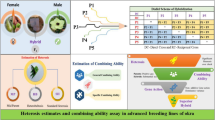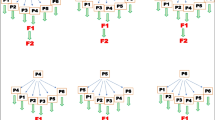Abstract
The combining abilities for physical-quality traits in peanut were examined to understand the type of gene action governing these traits, and to identify peanut genotypes suitable for use as parents in breeding for quality improvement. The F1 hybrids including reciprocals from a six-parent diallel cross along with the parents were evaluated in a randomised complete block design. Data were recorded on five quality traits in peanut viz., shelling outturn, 100-pod weight, 100-seed weight, Count and proportion of sound mature seeds. Substantial genetic variability was observed among the hybrids for the traits studied. Diallel analysis indicated that expression of majority of the quality traits is regulated predominantly by additive gene action suggesting possibility of early-generation selection, while non-additive gene action also plays an equally important role in the control of seed size. Significant reciprocal effect for all the traits denoted role of maternal parent in the expression of quality traits and importance of parental selection in quality breeding. Genotypes ICGV 86564 and TPG 41 were good combiners for seed size, while J 11 was a good combiner for improvement of shelling outturn and proportion of mature seeds. Association between general combining ability (GCA) effects and mean performance suggested that the performance per se of the genotype should be a good indicator of its ability to transmit the desirable quality attributes to its progenies. Though performance of crosses was found to be independent of parental GCA status, it is evident that at least one of the parents used in hybridisation should have large pods and seeds for obtaining better segregants.
Similar content being viewed by others
References
Anderson WF, Fitzner MS, Isleib TG, Wynne JC, Phillips TD (1993) Combining ability for large pod and seed traits in peanut. Peanut Sci 20(1):49–52
Anonymous (1997) Progress Report 1996–97, Rabi/Summer Groundnut Workshop, Oct. 6–7, 1997, p. II. Project Coordinating Unit, National Research Centre for Groundnut, P.B. No.5, Junagadh 362 001, Gujarat, India
Dwivedi SL, Nigam SN (2005) Confectionery groundnuts: issues and opportunities to promote export and food uses in India. J Oilseeds Res 22:1–4
Dwivedi SL, Thendapani K, Nigam SN (1989) Heterosis and combining ability studies and relationship among fruit and seed characters in peanut. Pean Sci 16(1):14–20
Dwivedi SL, Nigam SN, Nagabhushanam GVS, Rao YLC, Gibbons RW (1994) Registration of ICGV 86564 peanut germplasm. Crop Sci 34:821
Gan SM, Cao YL, Wei JX, Cui WT, Gu SY, Liu FS (1981) Studies on combining ability of quantitative characters in groundnut. Zhongguo Youliao Chinese Oil Crops 3:31–43
Garet B (1976) Heterosis and combining ability in groundnut (Arachis hypogaea L.). Oleagineux 31:435–442
Griffing B (1956) Concept of general and specific combining ability in relation to diallel crossing systems. Aust J Biol Sci 9:463–493
Kale DM, Murty GSS, Badigannavar AM (2004) TPG 41: a new large-seeded groundnut variety released in India. Int Arachis Newsl 24:21–22
Labana KS, Sangha AS, Hussain I (1981) Combining ability analysis in groundnut. Crop Improv 8:116–119
Mehan VK, McDonald D, Nigam SN, Lalitha B (1981) Groundnut cultivars with seed resistant to invasion by Aspergillus flavus. Oleagineux 36:501–507
Nava A, Layrisse A (1987) Diallel cross analysis of six peanut cultivars in the F1 and F2 generation. Proceedings, American Peanut Research and Education Society 19:17
Nigam SN, Dwivedi SL, Rao YLC, Gibbons RW (1991) Registration of ‘ICGV 87141’ peanut. Crop Sci 31:1006
Panse VG, Sukhatme PV (1985) Statistical methods for agricultural workers. Indian Council of Agricultural Research, New Delhi, India, p 359
Parmar DL, Kumar ALR, Bharodia PS (2000) Genetic analysis of pod and seed characters in crosses of large-seeded Virginia genotypes of groundnut. Int Arachis Newsl 20:10–11
Rojas BA, Sprague GF (1952) A comparison of various components in corn yield traits. General and specific combining ability and their interaction with locations and years. Agron J 44:462–466
Singh M, Labana KS (1980) Combining ability in groundnut. Crop Improv 7:123–128
Singh RK, Chaudhary BD (1985) Biometrical methods in quantitative genetic analysis. Kalyani Publishers, New Delhi, p 318
Sprague GF, Tatum LA (1942) General vs. specific combining ability in single cross of corn. J Am Soc of Agron 34:923–932
Vindhiyavarman P (2000) Combining ability estimates in groundnut (Arachis hypogaea L.). Madras Agric J 87:462–466
Vindhiyavarman P (2001) Genetic analysis of recovery percentage and maturity index in groundnut. Madras Agric J 88:119–122
Wynne JC, Rawlings JO, Emery DA (1975) Combining ability estimates in Arachis hypogaea L. III. F2 generation of intra- and intersubspecific crosses. Peanut Sci 2(2):50–54
Author information
Authors and Affiliations
Corresponding author
Rights and permissions
About this article
Cite this article
Hariprasanna, K., Lal, C., Radhakrishnan, T. et al. Analysis of diallel cross for some physical-quality traits in peanut (Arachis hypogaea L.). Euphytica 160, 49–57 (2008). https://doi.org/10.1007/s10681-007-9553-9
Received:
Accepted:
Published:
Issue Date:
DOI: https://doi.org/10.1007/s10681-007-9553-9




